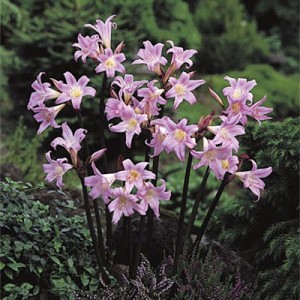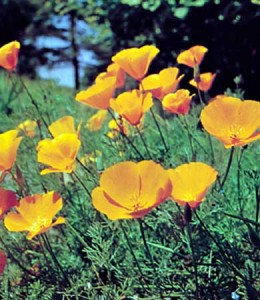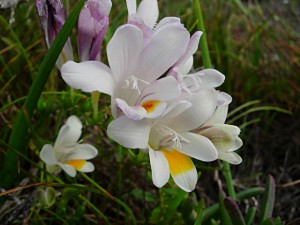Three very drought tolerant annuals and bulbs
You don’t have to have a dull, colorless garden just because you are transitioning your plant palette to drought tolerant species. The following bulbs and annuals are gorgeous, and are very low water users. In fact, they often survive on winter rains alone and reseed or regenerate themselves each year. They are no fuss, easy-care plants perfect for the natural garden.
 Naked Lady – (Amaryllis belladonna) is a bulb plant and hails from South Africa. During the rainy season, Naked Lady produces a lush mound of bright green strappy leaves. These leaves go dormant in the dry summer sun. You might think she is dead, but lo and behold a month or so later 2-3’ foot bare flowering stalks emerge with clusters of large, pink, jazzy, aromatic, trumpet-like flowers on top. Naked lady prefers full-sun and good-draining soil. Plant her behind a 12-18” plant to hide the dormant leaf clusters mid-summer.
Naked Lady – (Amaryllis belladonna) is a bulb plant and hails from South Africa. During the rainy season, Naked Lady produces a lush mound of bright green strappy leaves. These leaves go dormant in the dry summer sun. You might think she is dead, but lo and behold a month or so later 2-3’ foot bare flowering stalks emerge with clusters of large, pink, jazzy, aromatic, trumpet-like flowers on top. Naked lady prefers full-sun and good-draining soil. Plant her behind a 12-18” plant to hide the dormant leaf clusters mid-summer.
 California poppy – (Eschscholzia californica), our much beloved state flower, is my favorite. It emerges in the rainy season with fine, lacy, fern-like gray-green leaves. Brilliant orange, cup-shaped blossoms pack a visual punch starting around March. Poppies bloom for months. In the summer long, narrow green seedpods develop, turn tan-colored and eventually bust open casting seeds far and wide.
California poppy – (Eschscholzia californica), our much beloved state flower, is my favorite. It emerges in the rainy season with fine, lacy, fern-like gray-green leaves. Brilliant orange, cup-shaped blossoms pack a visual punch starting around March. Poppies bloom for months. In the summer long, narrow green seedpods develop, turn tan-colored and eventually bust open casting seeds far and wide.
If you want to contain where your poppies harvest the ripe seedpods, put them in a bag and cast them into well-drained soil in autumn. Poppies are not flowers for the neat-nick garden as they spread willy-nilly. They are great in meadows and on hillsides. They perform well as filler in natural gardens, or along paths or driveways. There are poppy cultivars that come in many lovely colors. These cultivars don’t typically keep their color from year to year and most revert back to orange. Poppies love the sun.
 Freesia (Freesia sp.) also originates from South Africa. It has a dreamy scent, is available in a bundle of different flower colors – white, cream, yellow, pink, purple, etc. The flowers grow 1-2” long and are tubular with a flare on the end. Freesias bloom in late winter and spring.
Freesia (Freesia sp.) also originates from South Africa. It has a dreamy scent, is available in a bundle of different flower colors – white, cream, yellow, pink, purple, etc. The flowers grow 1-2” long and are tubular with a flare on the end. Freesias bloom in late winter and spring.
According to Teleflora.com, freesias symbolize innocence and friendship. In my experience freesias sometimes have the lazy habit of laying down on the job. In other words the flowering stalks sometimes spread horizontally just above the soil-line. Freesia’s 8-12” strappy leaves go dormant in the summer. Freesia prefer sun to part-shade and well-drained soil. Install freesia corms in fall just before the rainy season starts.
Karen Boness is a Sonoma-based landscape designer, certified arborist and licensed contractor #974035. Her business is Wild Willow Landscape Design, 481.8561. Wildwillow.com



